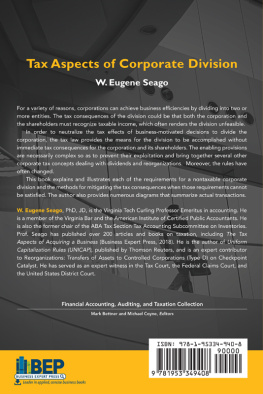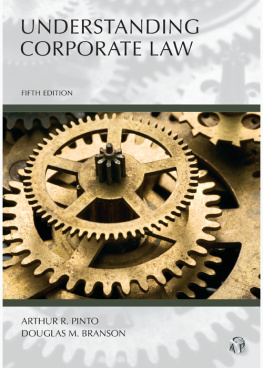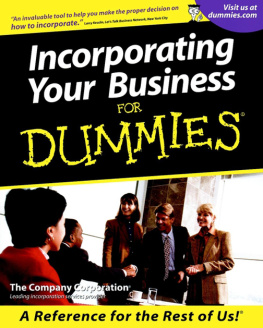
Tax Aspects of Corporate Division
Tax Aspects of Corporate Division
W. Eugene Seago

Tax Aspects of Corporate Division
Copyright Business Expert Press, LLC, 2021.
All rights reserved. No part of this publication may be reproduced, stored in a retrieval system, or transmitted in any form or by any meanselectronic, mechanical, photocopy, recording, or any other except for brief quotations, not to exceed 250 words, without the prior permission of the publisher.
First published in 2021 by
Business Expert Press, LLC
222 East 46th Street, New York, NY 10017
www.businessexpertpress.com
ISBN-13: 978-1-95334-940-8 (paperback)
ISBN-13: 978-1-95334-941-5 (e-book)
Business Expert Press Financial Accounting, Auditing, and Taxation Collection
Collection ISSN: 2151-2795 (print)
Collection ISSN: 2151-2817 (electronic)
Cover design by Charlene Kronstedt
Interior design by S4Carlisle Publishing Services Private Ltd., Chennai, India
First edition: 2021
10 9 8 7 6 5 4 3 2 1
Printed in the United States of America.
Description
For a variety of reasons, corporations can achieve business efficiencies by dividing into two or more entities. The tax consequences of the division could be that both the corporation and the shareholders must recognize taxable income, which often renders the division unfeasible.
In order to neutralize the tax effects of business-motivated decisions to divide the corporation, the tax law provides the means for the division to be accomplished without immediate tax consequences for the corporation and its shareholders. The enabling provisions are necessarily complex so as to prevent their exploitation and bring together several other corporate tax concepts dealing with dividends and reorganizations. Moreover, the rules have often changed.
This book explains and illustrates each of the requirements for a nontaxable corporate division and the methods for mitigating the tax consequences when those requirements cannot be satisfied. The author also provides numerous diagrams that summarize actual transactions.
Keywords
useful to practitioners and students, analytical, current, explains the tax rules and their rationale, illustrates the applications of the law to frequently encountered transactions
Contents
In a variety of circumstances management of a corporation may have good business reasons for dividing the corporation into two or more corporations in such a manner that shareholders in the original corporation own stock in each of the resulting entities. This may mean that assets must be moved from one corporate shell to another and stock must be distributed to the shareholders. Thus, under the general rules of taxation, the original corporation and their shareholders would realize taxable income. However, under certain conditions the realized gains are not taxed at the time of the distribution or exchange.
This book discusses the reasons the Internal Revenue Code provisions governing corporate division were first added to law, how the law was used and abused, and then how it was changed to curb the perceived abuses. The tax laws establish the conditions under which the division may occur without the recognition of gain by the corporation and the shareholders: These conditions relate to the business purpose, and continuity of investment, which are generally required for corporate restructuring. However, a corporate division provides opportunities for abuses of the laws. Any corporate management contemplating a division must be aware of the statutory safeguards against abuse built into the law, whether or not any abuse is intended.
serves as a review of the materials in the other chapters by discussing specific factual situations where the law has been applied.
As will be seen, corporate division often brings into play a variety of corporate tax laws, including distributions, reorganizations, stock redemptions and consolidated tax returns. Moreover, a corporate division is often integrated with other transactions, which creates issues about which steps must be considered in evaluating the corporate division. Thus, guiding clients through a corporate division requires the application of the practitioners cumulate knowledge and skills. Corporate division is where the practitioner must put it all together.
Introduction
This book is about the tax consequence of dividing a corporation into two or more corporate entities. The division usually takes the form of a spin-off, split-off, or a split-up.
In a spin-off, a corporation distributes to its shareholders a controlling in the stock of a subsidiary. In another form of a spin-off, a corporation may transfer some of its assets to a newly formed corporation in exchange for all of the corporations stock, which the parent corporation distributes to its shareholders. For the shareholder, the spin-off is equivalent to a dividend in the form of stock in another corporation, and for the distributing corporation, the spin-off is economically equivalent to paying a dividend to its shareholders in the form of stock in another corporation.
A split-off is the same as a spin-off, except that not all of the shareholders participate: That is, the parent corporation transfers its stock that is a controlling interest in a subsidiary to one or a limited group of its shareholders in exchange for their stock in the distributing corporation. The split-off is essentially a stock redemption.
A split-up is similar to a spin-off, except that all the assets of a corporation are divided between two new corporations in exchange for all of their stock. Then the original corporation distributes to its shareholders the stock in the two corporations, and the original corporation dissolves. For the shareholders, the split-up is similar to a stock dividend.
In each of these three types of transactions, the corporation and the shareholders have altered their property rights through exchanges and distributions. Therefore, under the general rules of taxation, realized gains or losses must be recognized. However, the tax law contains specific rules for these transactions that provide the corporation the unique ability to distribute property to its shareholders without the corporation and its shareholders incurring a tax liability.
Rationale for the Exception
The Spin-Off
In a multitude of situations, corporate management may determine that for good business reasons, the shareholders should directly own the corporations subsidiary or that the corporation should be divided into two or more corporations. If the general rules for the taxation of corporations and their shareholders were applied, a substantial tax burden could accompany the implementation of the business decision. Thus, the tax laws would not be neutral in regard to this type of business decision. The lack of neutrality in the tax laws can also work in the other direction: That is, the tax laws can also create benefits such that actions will be undertaken primarily to achieve the tax benefit, rather than to achieve a business purpose. Thus, over the past 100 years, the tax laws regarding corporate division have undergone substantial changes in an attempt to make the tax laws neutral in the sense of not interfering with business-motivated decisions but without creating tax-motivated transactions.
The need to neutralize the tax laws in regard to business decisions is illustrated by an early case, Rockefeller v. United States,
Some shareholders in Rockefeller may have depended upon the corporate dividends for their ordinary living expenses. The tax on the value of the stock distributed could necessitate the shareholder selling some of the stock to pay the tax. However, the stock sale could give rise to more tax on the gain and, thus, it would be necessary to sell more stock, which, in turn, would create a still greater tax liability. The point is that it was not difficult to build the case that taxing the spin-off that was compelled by government regulations, rather than to achieve a tax objective, would be bad tax policy. Moreover, if the division was based on a valid business reason and the benefit the shareholder enjoyed from the distribution was the ability to sell stock in one of the businesses and retain the ownership interest in the other business, but the shareholder did not sell the stock in either corporation, why penalize the shareholders? Therefore, Congress enacted laws to create the nontaxable spin-off to counter the results reached in
Next page










